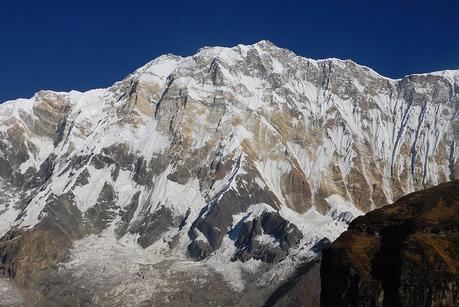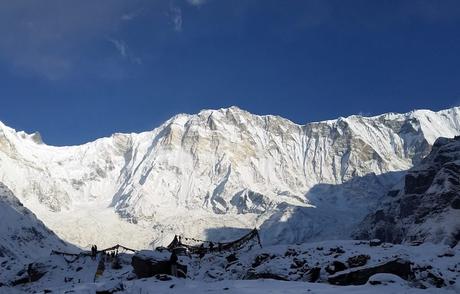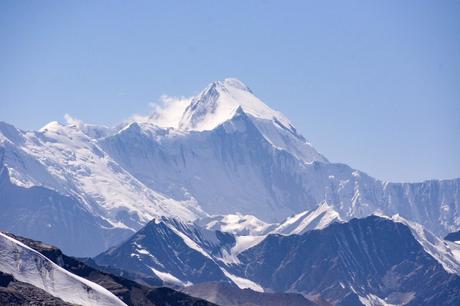It has been another very busy week in the Himalaya. On Mt. Everest, the teams began filing into Base Camp with a few groups already passing through the dreaded Khumbu Icefall on their way up to Camp 1. This will be the first of several acclimatization rotations as the climbers prepare their bodies for the thin air that will come at higher altitudes.
But while the teams on Everest are just getting started, climbers were finding an unprecedented level of success elsewhere. Last Friday a new Annapurna summit record was set when a large continent of alpinists made the final push, potentially taming a peak that is one of the deadliest on the planet.

The Most Dangerous Climb
Standing 8091 meters (26,545 ft.) tall, Annapurna ranks 10th amongst the world's highest peaks. Because of this, you might think that it is a piece of cake to climb compared to Everest, K2, or even Lhotse. But the mountain is know for its notoriously bad weather and high risks of avalanches, both of which have conspired to keep many skilled alpinists from ever reaching its summit.
Those conditions, combined with difficult technical climbing at altitude, have earned Annapurna the reputation of being the deadliest of all of the 8000 meter peaks. The death rate on the mountain hovers at a terrifying 33%-meaning one in ever three climbers perishes on its lofty slopes. For comparison sake, K2's death rate is more like 25% while Everest falls to around 1.5% or so.
Many of the deaths on Annapurna have been the result of avalanches that occur between Camp 2 and Camp 3. This has led to a change in strategy in recent years, with more climbers attempting the mountain earlier in the season, when the colder temperatures create more stable snow conditions. Because of this, teams arrive in Annapurna Base Camp in early March and endure winter in the Himalaya so that they can summit around mid-April. That's about a month earlier than we would expect summits to occur on Everest.

Starts and Stops
Because of the COVID pandemic, it has been more than two years since anyone has stood on the summit of Annapurna. This has led to a relatively large group of climbers on the mountain this spring. While the number of mountaineers heading to this peak will never reach the same levels as Everest, for 2021 Base Camp was busy, active, and full.
The Annapurna climbing season went pretty much by the book early on, with teams working on their acclimatization rotations early on. Most spent at least one or two nights in Camp 1 and 2 as the prepped for their final push, keeping one eye on the weather forecast as a projected summit window neared. That window opened early last week, with most teams heading up with an eye on reaching the top on Tuesday or Wednesday.
Unfortunately, conditions on the mountain caused some unforeseen logistical challenges. As the climbers made their way up they discovered that the lack of snow in the Himalaya this year had exposed hard blue ice, making the climb much harder and slower. The route also required the rope fixing team to use more line, which eventually caused them to run out rope altogether. This forced the climbers to retreat back to Camp 4 to spend another night in a place that isn't know for being comfortable.

Record Annapurna Summits
With the teams stuck in place, the logistical team sent an urgent request out for more ropes. A helicopter was called in to deliver the lines on Friday, allowing the group to get moving again. With the much needed supplies in hand, the rope fixing team was able to finish their work, paving the way for others to follow. The route wouldn't be easy however, as a storm dumped 40 cm (16 inches) of fresh snow, which ultimately slowed things down but didn't prevent a slew of summits.
According to ExWeb, which has a complete rundown of the successful climbers, more than 70 people stood on the summit of Annapurna on April 16. This includes the foreign alpinists and their Sherpa guides, who recorded the first successful ascents of the spring climbing season.
To put things into perspective, Alan Arnette tells us that Annapurna has only been summited 298 times previously-a number that went up substantially, while also lowering the death rate at the same time. Friday's summits also saw the most female climbers top out in the same year as well, with 18 women completing the ascent.
A Sign of Things to Come on Everest?
Annapurna's new summit record could potentially be a preview of what to expect on Mt. Everest in a couple of weeks. Initially it was thought that due to COVID, there would be a limited number of climbers on the Big Hill this season. But as the weeks have progressed an increasing number of teams and mountaineers are now making their way towards the mountain. In fact, as of this writing, more than 340 permits have been issued for the world's highest peak, rivaling the record setting year of 2019. Interestingly enough, another 104 permits have been issued for nearby Lhotse as well.
The endearing image from the 2019 season is the long line of climbers who were waiting to make their way up to the summit. This was brought on by a large number of individuals on Everest and a narrow weather window for safely approaching the top. If the window is a small one again this season, we could see a similar situation, potentially leading to overcrowding. But with a month or so to go until the summit pushes begin, it's impossible to know if this will be the case.
Right now, it seems very unlikely that Everest will see a new summit record of its own, but there are still a large number of people on the mountain despite the ongoing pandemic. With a normal success rate however, we could see somewhere in the neighborhood of 750-800 total summits. A number that would have been staggering just a few years ago but is now seen as "down" compared to 2019.
A lot can happen between now and the end of the season, but it is shaping up to be one of the busiest ever on Everest. Lets hope it is safer than 2019, which saw 11 deaths on the mountain. The next three to four weeks should be incredibly interesting to watch unfold.



